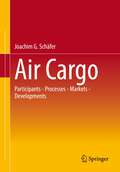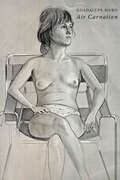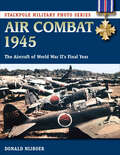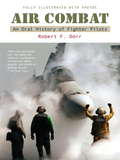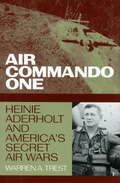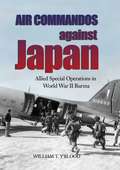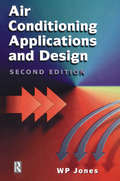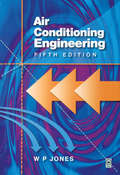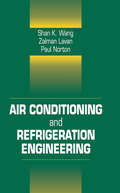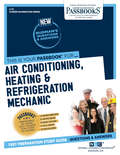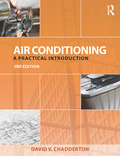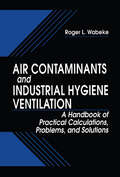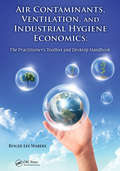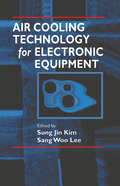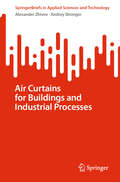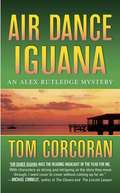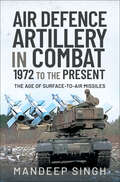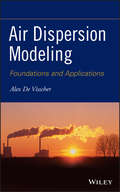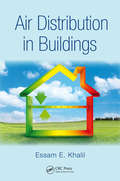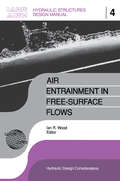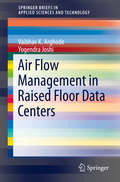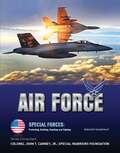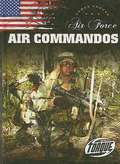- Table View
- List View
Air Cargo: Participants - Processes - Markets - Developments
by Joachim G. SchäferThis book uses numerous examples to describe the current opportunities and risks of air freight against the backdrop of stagnating transport volumes since the financial crisis in 2008. It shows what impact these developments have had on those involved, in particular shippers, airlines, airports and freight forwarders. The application-oriented presentation also provides an insight into the design of complex supply chains and the areas of tension in which the players in air freight operate.
Air Carnation
by Guadalupe MuroGuadalupe Muro, recipient of the Raul Urtusan - Frances Harley Scholarship for Young Emerging Artists from Argentina, has always had her own unique way of experiencing life. When applied to her writing, Muro says she finally "felt like a dog deciding to be a dog." Muro's Spanish publications have achieved strong acclaim, and now, BookThug is proud to introduce this remarkable new talent to the Canadian literary market. Air Carnation features an absorbing narrative that bridges non-fiction and fiction, poetry and song, as Muro explores themes of independence in love and the writerly life. With sojourns in Argentina, Buenos Aires, New York, Washington, and a cross-Canada train passage from Edmonton to Toronto, Air Carnation is an affecting work that will have readers laughing, crying, and all the while, enjoying this fascinating meta-fiction that sings of hippiedom in Patagonia.
Air Castle of the South: WSM and the Making of Music City
by Craig HavighurstStarted by the National Life and Accident Insurance Company in 1925, WSM became one of the most influential and exceptional radio stations in the history of broadcasting and country music. WSM gave Nashville the moniker "Music City USA" as well as a rich tradition of music, news, and broad-based entertainment. With the rise of country music broadcasting and recording between the 1920s and '50s, WSM, Nashville, and country music became inseparable, stemming from WSM's launch of the Grand Ole Opry, popular daily shows like Noontime Neighbors, and early morning artist-driven shows such as Hank Williams on Mother's Best Flour. Sparked by public outcry following a proposal to pull country music and the Opry from WSM-AM in 2002, Craig Havighurst scoured new and existing sources to document the station's profound effect on the character and self-image of Nashville. Introducing the reader to colorful artists and businessmen from the station's history, including Owen Bradley, Minnie Pearl, Jim Denny, Edwin Craig, and Dinah Shore, the volume invites the reader to reflect on the status of Nashville, radio, and country music in American culture.
Air Combat 1945: The Aircraft of World War II's Final Year (Stackpole Military Photo Series)
by Donald NijboerA detailed and fully illustrated look at aerial combat in the closing year of WWII across all theaters of conflict. The final year of World War II witnessed the decline of the piston-engine fighter and the beginning of the jet age. Taking to the skies were tried-and-true fighters, improved versions of old aircraft, and newly developed jets, including prototypes that flew for the first time just before the war ended. In Air Combat 1945, historian Donald Nijboer examines these dynamic aircraft through hundreds of wartime photographs depicting operations across Europe, the Mediterranean, and the Pacific. This volume covers American Mustangs, Thunderbolts, and Shooting Stars; British Tempests, Spitfires, and Gloster Meteors; German Fw 190s, Bf 109Ks, and Messerschmitt Me 262s; Japanese Ki 100s, Raidens, and Tojos; and many more.
Air Combat: A History of Fighter Pilots
by Robert F. DorrIn Air Combat, veteran and military author Robert F. Dorr has collected dozens of interviews from combat veterans who have faced the enemy in the skies above-from the first days of World War II to the current war on terror. Each story offers a firsthand account of what it's like to be in the thick of the fight, describes the history, strengths, and weaknesses of each man's plane in detail, and offers readers a rare glimpse into the minds and hearts of those who dare to fight in the air.
Air Commando One
by Warren A. TrestAir-dropping agents deep behind enemy lines in clandestine night missions during the Korean War, commanding secret flights into Tibet in 1960 to support the anticommunist guerilla uprising, participating in plans for the 1962 Bay of Pigs invasion--even before the escalation of the Vietnam War, Brigadier General Harry C. "Heinie" Aderholt worked at the heart of both the U.S. Air Force and CIA special operations worldwide. In 1964 he became commander of the famed First Air Commando Wing, fighting to build up special operations capabilities among the American and South Vietnamese airmen. In 1966 and 1967 he and his men set the record for interdicting the flow of enemy trucks over the Ho Chi Minh Trail in Laos and North Vietnam.Drawing on official records, personal papers, and interviews with Aderholt and many who worked with him, Air Force historian Warren A. Trest details the life and career of this charismatic, unconventional military leader who has become a legend of the Cold War Air Force. He tells how Aderholt's vigorous support of low-flying, propeller-driven aircraft and nonnuclear munitions pitted him against his superiors, who were steeped in doctrines of massive retaliation and "higher and faster" tactical air power. In the mid-1960s Aderholt's clash with Seventh Air Force Commander General William W. Momyer reflected a schism that still exists between the traditional Air Force and its unconventional special operations wings. The book also integrates U.S. Air Force and CIA accounts of some of the most pivotal events of the past fifty years.
Air Commandos Against Japan
by William T. Y'BloodIn 1943 the U.S. Army Air Forces created what would become the Air Commandos, a unit that marked a milestone in tactical operations in support of British ground forces invading Burma. William T. Y'Blood tells the story of how these daring American aviators trained and went into combat using unconventional hit-and-run tactics to confuse the enemy and destroy their lines of communication and supply. The force comprised light planes to evacuate wounded, transports to move heavy cargo, fighters, gliders, helicopters, and more than five hundred men. The book describes how this top-secret force successfully attacked the enemy from the air, resupplied British commandos on the ground, and airlifted the wounded out of the battle area--eventually driving the Japanese out of Burma.
Air Conditioning Application and Design
by W.P. JonesIntended for advanced students of building services, this practical book describes the design of air conditioning systems. Readers are assumed to have a knowledge of the basic principles of air conditioning, which are covered in the companion volume Air Conditioning Engineering. This new edition takes account of the latest building codes and pays greater attention to energy conservation. The section on systems characteristics is expanded and extensively revised to take account of developments in the technology of air conditioning since publication of the previous edition. There are expanded sections on specialist applications such as systems for clean rooms in the semiconductor industry. The author has wide experience both in lecturing on the subject and in the practical design and installation of air conditioning systems.
Air Conditioning Engineering
by W.P. JonesDesigned for students and professional engineers, the fifth edition of this classic text deals with fundamental science and design principles of air conditioning engineering systems. W P Jones is an acknowledged expert in the field, and he uses his experience as a lecturer to present the material in a logical and accessible manner, always introducing new techniques with the use of worked examples.
Air Conditioning and Refrigeration Engineering (Engineering Handbooks)
by Shan K. Wang, Zalman Lavan and Paul NortonAn air conditioning system consists of components and equipment arranged in sequential order to control and maintain an indoor environment. The goal is to provide a healthy and comfortable climate with acceptable air quality while being energy efficient and cost effective. Air Conditioning and Refrigeration Engineering covers all types of systems from institutional and commercial to residential.The book supplies the basics of design, from selecting the optimum system and equipment to preparing the drawings and specifications. It discusses the four phases of preparing a project: gathering information, developing alternatives, evaluating alternatives, and selling the best solution. In addition, the author breaks down the responsibilities of the engineer, design documents, computer aided design, and government codes and standards.Air Conditioning and Refrigeration Engineering provides you with an easy reference to all aspects of the topic. This resource addresses the most current areas of interest, such as computer-aided design and drafting, desiccant air conditioning and energy conservation. It is a thorough and convenient guide to air conditioning and refrigeration engineering.
Air Conditioning, Heating and Refrigeration Mechanic: Passbooks Study Guide (Career Examination Series)
by National Learning CorporationThe Air Conditioning, Heating and Refrigeration Mechanic Passbook® prepares you for your test by allowing you to take practice exams in the subjects you need to study. It provides hundreds of questions and answers in the areas that will likely be covered on your upcoming exam, including but not limited to: principles and practices of air conditioning and refrigeration; principles and practices of heating and ventilation systems; inspection, operation, maintenance and repair of basic mechanical equipment; reading and interpretation of plans and specifications; and more.
Air Conditioning: A Practical Introduction
by David V. ChaddertonDavid Chadderton's Air Conditioning is the complete introduction and reference guide for students and practitioners of air conditioning design, installation and maintenance. The scientific principles involved are introduced with the help of case studies and exercises, and downloadable spreadsheets help you work through important calculations. New chapters on peak summertime air temperature in buildings without cooling systems, air duct acoustic calculations and air conditioning system cost enhance the usefulness to design engineers. Case studies are created from real life data, including PROBE post-occupancy reports, relating all of the theoretical explanations to current practice. Trends and recent applications in lowering energy use by air conditioning are also addressed, keeping the reader informed of the latest sustainable air conditioning technologies. Over 75 multiple choice questions will help the reader check on their progress. Covering both tropical and temperate climates, this is the ideal book for those learning about the basic principles of air conditioning, seeking to understand the latest technological developments, or maintaining a successful HVAC practice anywhere in the world.
Air Contaminants and Industrial Hygiene Ventilation: A Handbook of Practical Calculations, Problems, and Solutions
by RogerL. WabekeThe industrial hygienist is actively involved with the engineering community, particularly where the subject of industrial ventilation is concerned. While engineers concentrate on methods and techniques necessary to ensure maximum efficiency of a given system, the industrial hygienist concentrates on human health.Ventilation is one of the most widely used methods of controlling environmental eontaminates, and for this reason, industrial hygienists must have specific knowledge of the design of equipment and the principles which it operates.This informative text, written in easily understood language, will allow those without a mechanical engineering background to understand air calculation and ventilation problems. Industrial Hygiene Ventilation provides the industrial hygienist with a handy reference containing the equations, constants, conversions, and formulae that they will encounter in their day to day duties.
Air Contaminants, Ventilation, and Industrial Hygiene Economics: The Practitioner's Toolbox and Desktop Handbook
by Roger Lee WabekeThere is nothing more devastating to baseless opinions than good numbers. Air Contaminants, Ventilation, and Industrial Hygiene Economics: The Practitioner's Toolbox and Desktop Handbook helps you obtain "good numbers" on your quest to squash shabby opinions with sound advice. It details real-world applications of good numbers to foster improvement
Air Cooling Technology for Electronic Equipment
by Sung Jin Kim Sang Woo LeeClear your bookcase of references containing bits and pieces of useful information and replace them with this thorough, single-volume guide to thermal analysis. Air Cooling Technology for Electronic Equipment is a helpful, practical resource that answers questions frequently asked by thermal and packaging engineers grappling with today's demand for increased thermal control in electronics. Superbly organized for quick reference, the book dedicates each chapter to answering fundamental questions, such as: What is the optimal spacing between the printed circuit boards? What is a good estimate of the heat transfer coefficient and the associate pressure drop for forced convection over package arrays? How are heat transfer and fluid flow characteristics in the entrance region different from those in the fully developed region? What is the effect of substrate conduction on convection cooling?The chapters, written by engineers and engineering educators who are experts in electronic cooling, are packed with details and present the latest developments in air cooling techniques and thermal design guidelines. They provide problem-solving analyses that are jargon-free, straightforward, and easy to understand. Air Cooling Technology for Electronic Equipment is a handy source of technical information for anyone who wants to get the most out of air cooling.
Air Curtains for Buildings and Industrial Processes (SpringerBriefs in Applied Sciences and Technology)
by Alexander Zhivov Andrey StronginThis book is based on several decades of authors’ research and practical experience in the areas of industrial and commercial buildings ventilation and energy efficiency as well as in process optimization in different types of industrial facilities. The Book discusses different types of air curtains used around the world and describes design, applications, pros and cons and examples for each type of air curtain. The book is illustrated with schematics of air curtains and pictures from their real-life implementation from around-the -world. To compare various design of air curtains, authors propose several indicators/efficiency criteria, which address effectiveness of air curtains, their energy and performance efficiency. The target audience for this book are energy and process engineers and designers of large commercial and industrial facilities, warehouses, and hangars.
Air Dance Iguana
by Tom CorcoranAlex Rutledge strayed from ad agency photo jobs to tropical magazine assignments. He went for extra income in the crime scene business, but now he wants out. He misses his carefree Key West lifestyle. Then his lover, Detective Bobbi Lewis, is on the phone. She asks Alex to document Monroe County's first hanging in thirty years. Within hours he confronts a second murder and an abrasive investigator new to the Keys. He's also reminded that you can't pick your relatives. ... AND "COMES-AROUND" BRINGS NO CLUES. The cops want to think that Alex's brother, Tim, new in town with his shady past, might be a killer. Tim has messed up his life, so Alex doesn't know what to believe. As he digs deeper with photo evidence, Alex finds clues the cops have missed- or covered up. He suspects revenge when he digs up connections to a decades-old unsolved crime. Then, when a third man is found hanged on a dock, Alex knows time is running out for his brother ... and maybe for himself.
Air Defence Artillery in Combat, 1972 to the Present: The Age of Surface-to-Air Missiles
by Colonel Mandeep Singh“It covers, chapter by chapter the anti-air battle in wars from Yom Kippur (1973) onwards . . . a readable, well researched and well-presented book.” —Army Rumour Service (ARRSE)Anti-aircraft artillery truly came into prominence during the Second World War, shooting down more aircraft than any other weapon and seriously affecting the conduct of air operations. Development continued into the Cold War, resulting in the extensive introduction of surface-to-air missiles, or SAMs. Though the first combat success of such weapons was during the Vietnam War, when a Soviet-designed S-75 Dvina missile shot down a USAF F-4C Phantom on 24 July 1965, it was the Yom Kippur War of 1973 which brought surface-to-air missiles to the center stage.During this short but bitter conflict, Egyptian and Syrian air defenses shot down nearly fifty Israeli aircraft in the first three days alone—almost a fourth of Israel’s entire combat aircraft fleet. In all, Israel lost 104 aircraft during the war and, for the first time, more aircraft were lost to SAMs than any other cause. The age of surface-to-air missiles had dawned.In this unique examination, the author details the development of not just surface-to-air missiles, but all anti-aircraft artillery, since 1972. The part that such equipment played in all of the major conflicts since then is explored, including the Soviet Afghan War, the Falklands War, in which Rapier was deployed, the conflict in Lebanon, Kosovo and Bosnia, the Gulf War, Operation Desert Storm in 1991, and Operation Iraqi Freedom in 1993. The investigation is brought right up to date by a study of the weapons, tactics and engagements seen in the conflicts in Syria and Yemen.
Air Dispersion Modeling: Foundations and Applications
by Alex De VisscherA single reference to all aspects of contemporary air dispersion modeling The practice of air dispersion modeling has changed dramatically in recent years, in large part due to new EPA regulations. Current with the EPA's 40 CFR Part 51, this book serves as a complete reference to both the science and contemporary practice of air dispersion modeling. Throughout the book, author Alex De Visscher guides readers through complex calculations, equation by equation, helping them understand precisely how air dispersion models work, including such popular models as the EPA's AERMOD and CALPUFF. Air Dispersion Modeling begins with a primer that enables readers to quickly grasp basic principles by developing their own air dispersion model. Next, the book offers everything readers need to work with air dispersion models and accurately interpret their results, including: Full chapter dedicated to the meteorological basis of air dispersion Examples throughout the book illustrating how theory translates into practice Extensive discussions of Gaussian, Lagrangian, and Eulerian air dispersion modeling Detailed descriptions of the AERMOD and CALPUFF model formulations This book also includes access to a website with Microsoft Excel and MATLAB files that contain examples of air dispersion model calculations. Readers can work with these examples to perform their own calculations. With its comprehensive and up-to-date coverage, Air Dispersion Modeling is recommended for environmental engineers and meteorologists who need to perform and evaluate environmental impact assessments. The book's many examples and step-by-step instructions also make it ideal as a textbook for students in the fields of environmental engineering, meteorology, chemical engineering, and environmental sciences.
Air Distribution in Buildings (Mechanical and Aerospace Engineering Series #54)
by Essam E. KhalilAir Distribution in Buildings is a concise and practical guide to air distribution system design and managing air conditioning systems in buildings. Making use of 40 years of experience in the design of air conditioning and ventilations systems, and other electromechanical services, this structured reference for built environment engineering offers
Air Entrainment in Free-surface Flow: IAHR Hydraulic Structures Design Manuals 4
by Ian R. WoodThis monograph is aimed at the practising hydraulic engineer. Work on it commenced at Professor Naudascher's instigation in 1982. Over the next six years all or some of the authors discussed progress at IAHR sponsored conferences at Esslingen, Melbourne, Lausanne and Beijing. With the authors scattered throughout the world, and all with other responsibilities, progress was bound to be slow. Completion was further delayed by the great increase in published technical literature in this area over the period 1982-1988. This literature continues to expand and with it our understanding of the air water flow phenomena. The monograph must therefore be seen as the authors' views on the state of the art around 1988. More recent references have been included for completeness.This monograph has been a joint effort with most authors making suggestions and contributions to more than one chapter. Nevertheless, the chapter authors are primarily responsible for the material in their chapters.Throughout the monograph symbols are defined when they are fist introduced and a list of symbols is included at the end of each chapter.Many other people have contributed to this monograph, but the authors would particularly like to acknowledge the assistance given by Professor John McNown who has read, commented on and improved the style of the complete monograph.
Air Flow Management in Raised Floor Data Centers (SpringerBriefs in Applied Sciences and Technology)
by Yogendra Joshi Vaibhav K. ArghodeThe Brief discuss primarily two aspects of air flow management in raised floor data centers. Firstly, cooling air delivery through perforated tiles will be examined and influence of the tile geometry on flow field development and hot air entrainment above perforated tiles will be discussed. Secondly, the use of cold aisle containment to physically separate hot and cold regions, and minimize hot and cold air mixing will be presented. Both experimental investigations and computational efforts are discussed and development of computational fluid dynamics (CFD) based models for simulating air flow in data centers is included. In addition, metrology tools for facility scale air velocity and temperature measurement, and air flow rate measurement through perforated floor tiles and server racks are examined and the authors present thermodynamics-based models to gauge the effectiveness and importance of air flow management schemes in data centers.
Air Force (Special Forces: Protecting, Building, Te)
by Gabrielle VanderhoofThe United States Air Force is among the best in the world. In the air, in space, and in cyberspace, the Air Force works to protect the United States from threats to the country's national security. The Air Force's Special Forces are highly trained to provide support to our servicemen and women as they take part in a variety of military and humanitarian efforts around the globe. This book gives readers a glimpse of what it takes to become a member of the U.S. Air Force, including the rigorous physical training each recruit must endure. You will learn: * How the Air Force assists in humanitarian efforts * What the Air Force is doing to battle viruses overseas. * How the Air Force works to support our troops fighting abroad in Iraq and Afghanistan.
Air Force Air Commandos (Torque Books: Armed Forces)
by Jack DavidFull-color photography accompanies exciting information about the Air Force air commandos. The combination of high-interest subject matter and light text is intended for students in grades 3 through 7.
